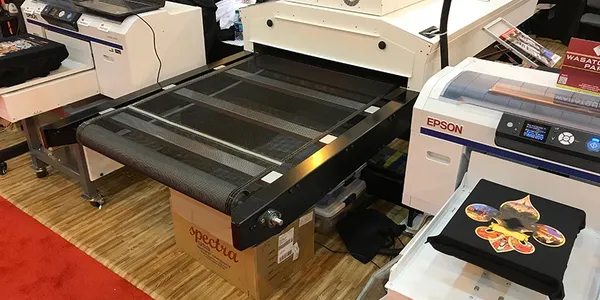
by Michael Best | Feb 15, 2024 | General interest
I believe that it was Zig Ziglar (1926 – 2012) who talked about working on your business rather than working in your business. He was making the point in the context of growing a business. More recently, I re-read an article I’d kept on file in which the same on-your-business-not-in-your-business point was raised in the context of a textile screen printing shop.
The article started out being about a shop with a printing probelm.They were dealing with a deadline order to print in white on burgundy nylon running shorts that they discovered were actually polyester shorts when the dye bled into the print. This led to to a closer examination of why this was allowed to happen and how the shop was being run. A list of management problems were unearthed in the process:
- A production manager running the press, leaving nobody to manage the production or run the shop.
- A poor screen-coating technique.
- A high temperature in the shop at around 49 Celsius.
- Accepting the job with too tight a deadline with no time allowed for dealing with problems.
- No standard operating procedure for minimizing problems.
- Poorly trained production staff.
Unfortunately, this is quite common in the industry. How does your shop stack up against this list of management problems? is someone managing to prevent crises?

by Michael Best | Feb 12, 2024 | General interest
I recently had my website developer install Wordfence, a website security service for WordPress sites. We’re trying out the free version at the moment on an e-commerce website I own and I’ve just received the first weekly report. To say that it was an eye opener would be to understate it’s impact.
The report on attacks from numbers of IPs, originating countries, and failed logins that Wordfence blocked and listed was astounding—they numbered in the hundreds. I would never have guessed the extent of nefarious activity out there. I asked our website host what the impact of this activity would have been before we engaged Wordfence. “Nothing, the sites we host are “hardened” which means that we lock down security. What Wordfence does that we cannot do as quickly, is stop attacks on plugins in which someone has found a vulnerability. WordPress plugin exploits are the number one way sites get hacked.”
But it was the answer to my question about why there had been 165 failed attempts to log in using my name and hundreds using speculative usernames like “admin”, “test”, “guest”, “username”, “123456789”, and others. “That is people trying to guess the passwords for the accounts. This is common and why passwords should be complex.”
So, I’ve changed my attitude to complex passwords. I’ve resolved to stop regarding them as a nuisance and to make sure that I follow the advice about changing passwords regularly and making them as random, unpredictable, and complex as possible. I urge you to as well. And perhaps consider a website security service—it’s rough out there in cyberspace.

by Michael Best | Feb 8, 2024 | General interest
So, the glitter and microplastic issue continues!
A few months ago I contacted the textile and apparel editor of a prominent printing industry online magazine and explained my quest to persuade textile screen printers to stop using glitter. She agreed to publish an article on the topic. I considered such an article about the glitter and microplastic problem in a prominent industry magazine a breakthrough, especially as another industry magazine chooses to turn a blind eye and still irresponsibly publishes articles promoting glitter prints.
The article was published. Unfortunately, it did little for my quest though and was actually disappointing for three main reasons.
First disappointment: After accurately listing the ecological problems associated with traditional aluminum and plastic glitter, she inaccurately suggested using “biodegradable” alternatives from two German manufacturers. I checked out their websites. One of the manufacturers makes a polyester glitter which is also a microplastic problem, and the other makes a plant-based glitter only for face and body applications specifically for the “party scene”—it has nothing at all to do with the textile industry.
Second disappointment: A footnote to the article says that the author wrote it with the assistance of Google’s Bard, an AI platform. Clearly, she did no research into the manufacturers Bard incorrectly included, thereby undermining the credibility of her article.
Third disappointment: When I pointed all of this out to her, the response was, “Oh well.” That’s it. No apology or correction offered. Just. “Oh well.”
The quest continues, but in the meantime, we’ve learned a couple of things from this exercise. First, so far there appears to be no legitimate “biodegradable” alternative to plastic and aluminum glitter and it’s hard to see how there could ever be—to be “biodegradable” the glitter would have to be water soluble, which makes it unsuited to any garment that has to be washed. And second, it’s probably a good idea to be a little skeptical about what we read in industry magazines, especially if it’s written with the assistnce of AI.

by Michael Best | Feb 5, 2024 | General interest
Who’s really your customer and what do they actually want? How much have you paused and contemplated that question?
Here is an of excerpt from Seth Godin’s book, This is Marketing, to demonstrate why you should contemplate the question as it relates to your business . . .
“Americans spent more than twenty-four billion dollars on dog food last year. The average price has has skyrocketed, and so has the gourmet nature of ingredients, like sweet potatoes, elk, and free-range bison..
And yet, I’ve never seen a dog buy dog food.
Have you?
Dog food might be getting more delicious as it gets more expensive, but we actually have no idea. We have no clue whether dogs enjoy it more, because we’re not dogs.
But we can be sure that the dog owners like it more.
Because dog food is for dog owners. It’s for the way it makes them feel, the satisfaction of taking care of an animal the responds with loyalty and affection, the status of buying a luxury good, and the generosity of sharing it.
Some dog owners want to spend more on the dog food they buy. Some want gluten-free dog food, loaded with high-value placebos.
But lets not get confused about who all this innovation is for. It’s not for the dogs.
It is for us.
A marketer for a dog food company might decide that the secret of more dog food sales is to make a food that tastes better. But that requires understanding how a dog thinks, which is awfully difficult.
It turns out that the right formula is to make a dog food that dog owners want to buy.”
Who’s really your customer and what do they actually want?

by Michael Best | Feb 1, 2024 | General interest
Last week I had a conversation with Pablo Forno of Grand Slam Sports of Okotoks, Alberta. I asked for the conversation because I’d heard that Pablo had an interesting perspective on the DTG versus screen printing debate. He had switched all his production from screen printing to direct to garment but a year later switched back a significant portion of his production to screen printing. I was interested to find out why.
Grand Slam Sports prints team uniforms in addition to regular, multi-colour prints on tees and sweats. The DTG printer is an Epson F2100 and the screen-printing press is a 4-colour, 4-station. Printing exclusively on the DTG printer wasn’t working for Pablo mainly because the garments have to be pre-treated and then racked to dry overnight. In addition to that, Pablo found that he had to heat press the garments to ensure that they were properly dry and ready for the printing.
For team uniforms that are usually polyester requiring only one or two-colour prints, he has found that it’s much quicker and more cost effective to screen print. But, the DTG printer is still used for short, multiple-colour runs.
So, if you’re considering a DTG printer you’d be well advised to consider it, not as a replacement for your screen-printing press, but rather as supplemental. And, of course, you need to have a very clear understanding of the financial impact and the cost-benefit aspect of the production balancing act you’re considering
Credit: Pablo Forno at www.grandslamcanada.com

by Michael Best | Jan 29, 2024 | General interest
A recent 16-page article written specifically for small business owners, attempted to explain the subtle difference between a mission statement and a vision statement. My Immediate reaction upon seeing the article was that the author didn’t have much experience dealing with small business owners. If he did, he’d know that his business-school theory may look good in print, but it’s chances of being read by the target audience were slim, and it’s chances of being implemented, even slimmer.
This doesn’t mean to say that it wasn’t a good article or that the theory wasn’t sound; it was a good article and the theory was sound. However, in practice, the average small business owner is a very busy person usually taking one day at a time and, under the circumstances, disinclined to take time out to read management theory articles.
But that doesn’t mean that small business owners shouldn’t be encouraged to consider missions and visions. However, they need to start wading at the shallow end. Expecting them to jump in boots and all at the deep end will only scare them off, and then an opportunity to implement a good business practice will have been lost. I consider it a success if I can persuade small business owners to take time out to just think about what they’re doing and where they want it all to go. Getting off the treadmill, standing back and calmly considering what they’re doing, what they want to accomplish, and what they’re going to do to get there, is a great start. That basic understanding and vision can then be built out gradually with the assistance of a consultant or accountant until it shapes up as a mission statement and even a vision statement to live by.
If this sounds like you and your business, you really need to take the first step on the way to developing mission and vision statements. Get off the treadmill for a couple of hours, go somewhere quiet and think about where the shop is at and where you want it to go. Then take that to an expert and get some help refining and formalizing it. It only makes good business sense.






